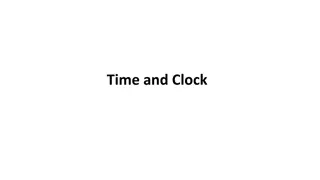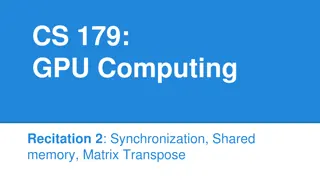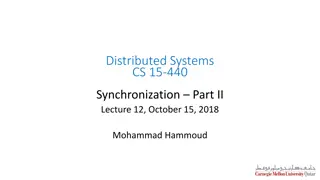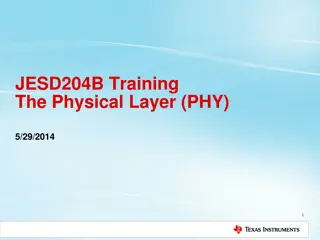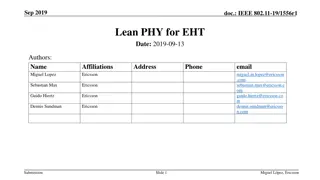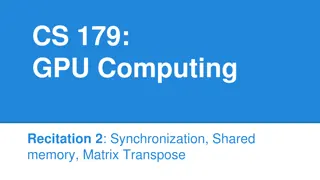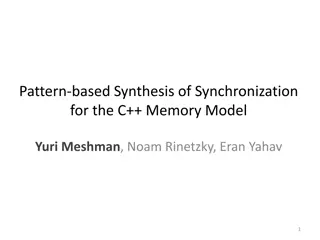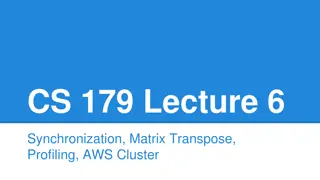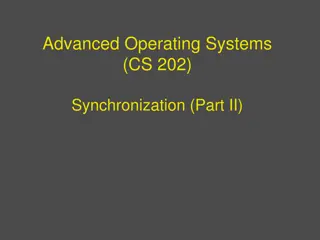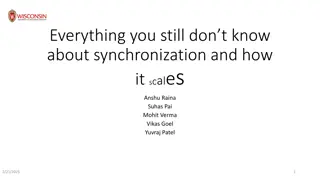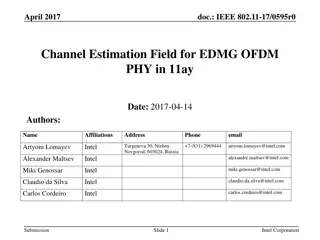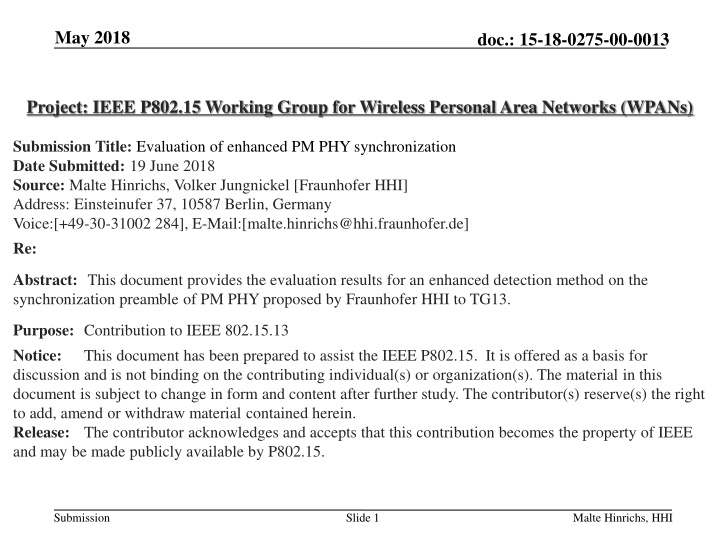
Enhanced PM.PHY Synchronization Evaluation Results
Explore enhanced detection method for synchronization in PM.PHY proposed by Fraunhofer HHI. Evaluation results cover observations, detection method details, synchronization reliability assessment, and more within IEEE 802.15 group framework.
Download Presentation

Please find below an Image/Link to download the presentation.
The content on the website is provided AS IS for your information and personal use only. It may not be sold, licensed, or shared on other websites without obtaining consent from the author. If you encounter any issues during the download, it is possible that the publisher has removed the file from their server.
You are allowed to download the files provided on this website for personal or commercial use, subject to the condition that they are used lawfully. All files are the property of their respective owners.
The content on the website is provided AS IS for your information and personal use only. It may not be sold, licensed, or shared on other websites without obtaining consent from the author.
E N D
Presentation Transcript
May 2018 doc.: 15-18-0275-00-0013 Project: IEEE P802.15 Working Group for Wireless Personal Area Networks (WPANs) Submission Title: Evaluation of enhanced PM PHY synchronization Date Submitted: 19 June 2018 Source: Malte Hinrichs, Volker Jungnickel [Fraunhofer HHI] Address: Einsteinufer 37, 10587 Berlin, Germany Voice:[+49-30-31002 284], E-Mail:[malte.hinrichs@hhi.fraunhofer.de] Re: Abstract: This document provides the evaluation results for an enhanced detection method on the synchronization preamble of PM PHY proposed by Fraunhofer HHI to TG13. Purpose: Contribution to IEEE 802.15.13 Notice: This document has been prepared to assist the IEEE P802.15. It is offered as a basis for discussion and is not binding on the contributing individual(s) or organization(s). The material in this document is subject to change in form and content after further study. The contributor(s) reserve(s) the right to add, amend or withdraw material contained herein. Release: The contributor acknowledges and accepts that this contribution becomes the property of IEEE and may be made publicly available by P802.15. Submission Slide 1 Malte Hinrichs, HHI
May 2018 doc.: 15-18-0275-00-0013 IEEE P802.15.13 Evaluation of enhanced PM PHY synchronization Date: 2018-07-09 Place: San Diego, CA Authors: Name Company Address Phone Email Malte Hinrichs Fraunhofer HHI Fraunhofer HHI malte.hinrichs@hhi.fraunhofer.de Volker Jungnickel volker.jungnickel@hhi.fraunhofer.de Submission Slide 2 Malte Hinrichs, HHI
May 2018 doc.: 15-18-0275-00-0013 Enhanced Detection Observations for S4/D7 at high OCR (doc. 18-170/r2): Exact synchronization not possible at OCR >50 MHz Cross correlation replicates shape of the CIR S4/D7: several high peaks Ideal sync position not distinct, lower peak energy Exploitable properties: Offset caused by CIR is small. For S4/D7: determined by max. distance between main peaks, i.e. ~20 ns (4 samples @200 MHz) Well within CP (160 ns) and correctable by equalization Peak energy is spread out in correlated signal, but not lost Can be detected through integration Submission Slide 3 Malte Hinrichs, HHI
May 2018 doc.: 15-18-0275-00-0013 Enhanced Detection Evaluated method: Cross correlation with ideal preamble Cross correlator output is integrated (running average) over a defined window length Detection of the preamble position with a tolerance of some samples Submission Slide 4 Malte Hinrichs, HHI
May 2018 doc.: 15-18-0275-00-0013 Evaluation Synchronization reliability according to IEEE 802.15.13 evaluation framework AWGN and Scenario 3, Device 3 (S3/D3): OCR 200 MHz Scenario 4, Device 7 (S4/D7): Optical Clock Rates 50..200 MHz 1,000 noise realizations (due to simulation time) Tolerance for detection: offset smaller than half the length of CP (i.e. 80 ns) Evaluation of different integration window lengths: 1 (no integration), 2, 4, 8 Original evaluation (see doc. 18-170/r2) for comparison Submission Slide 5 Malte Hinrichs, HHI
May 2018 doc.: 15-18-0275-00-0013 CIR Scenario 3, D3 Submission Slide 6 Malte Hinrichs, HHI
May 2018 doc.: 15-18-0275-00-0013 CIR Scenario 4, D7 Submission Slide 7 Malte Hinrichs, HHI
May 2018 doc.: 15-18-0275-00-0013 AWGN, 384 samples Enhanced Detection Submission Slide 8 Malte Hinrichs, HHI
May 2018 doc.: 15-18-0275-00-0013 S3/D3, 96 samples @200 MHz Enhanced Detection Submission Slide 9 Malte Hinrichs, HHI
May 2018 doc.: 15-18-0275-00-0013 S3/D3, 192 samples @200 MHz Enhanced Detection Submission Slide 10 Malte Hinrichs, HHI
May 2018 doc.: 15-18-0275-00-0013 S3/D3, 384 samples @200 MHz Enhanced Detection Submission Slide 11 Malte Hinrichs, HHI
May 2018 doc.: 15-18-0275-00-0013 S4/D7, 96 samples @50 MHz Enhanced Detection Submission Slide 12 Malte Hinrichs, HHI
May 2018 doc.: 15-18-0275-00-0013 S4/D7, 192 samples @50 MHz Enhanced Detection Submission Slide 13 Malte Hinrichs, HHI
May 2018 doc.: 15-18-0275-00-0013 S4/D7, 384 samples @50 MHz Enhanced Detection Submission Slide 14 Malte Hinrichs, HHI
May 2018 doc.: 15-18-0275-00-0013 S4/D7, 96 samples @100 MHz Enhanced Detection Submission Slide 15 Malte Hinrichs, HHI
May 2018 doc.: 15-18-0275-00-0013 S4/D7, 192 samples @100 MHz Enhanced Detection Submission Slide 16 Malte Hinrichs, HHI
May 2018 doc.: 15-18-0275-00-0013 S4/D7, 384 samples @100 MHz Enhanced Detection Submission Slide 17 Malte Hinrichs, HHI
May 2018 doc.: 15-18-0275-00-0013 S4/D7, 96 samples @200 MHz Enhanced Detection Submission Slide 18 Malte Hinrichs, HHI
May 2018 doc.: 15-18-0275-00-0013 S4/D7, 192 samples @200 MHz Enhanced Detection Submission Slide 19 Malte Hinrichs, HHI
May 2018 doc.: 15-18-0275-00-0013 S4/D7, 384 samples @200 MHz Enhanced Detection Submission Slide 20 Malte Hinrichs, HHI
May 2018 doc.: 15-18-0275-00-0013 AWGN, 384 samples Enhanced Detection Submission Slide 21 Malte Hinrichs, HHI
May 2018 doc.: 15-18-0275-00-0013 S3/D3, 96 samples @200 MHz Enhanced Detection Submission Slide 22 Malte Hinrichs, HHI
May 2018 doc.: 15-18-0275-00-0013 S3/D3, 192 samples @200 MHz Enhanced Detection Submission Slide 23 Malte Hinrichs, HHI
May 2018 doc.: 15-18-0275-00-0013 S3/D3, 384 samples @200 MHz Enhanced Detection Submission Slide 24 Malte Hinrichs, HHI
May 2018 doc.: 15-18-0275-00-0013 S4/D7, 96 samples @50 MHz Submission Slide 25 Malte Hinrichs, HHI
May 2018 doc.: 15-18-0275-00-0013 S4/D7, 96 samples @100 MHz Submission Slide 26 Malte Hinrichs, HHI
May 2018 doc.: 15-18-0275-00-0013 S4/D7, 96 samples @200 MHz Submission Slide 27 Malte Hinrichs, HHI
May 2018 doc.: 15-18-0275-00-0013 S4/D7, 192 samples @50 MHz Submission Slide 28 Malte Hinrichs, HHI
May 2018 doc.: 15-18-0275-00-0013 S4/D7, 192 samples @100 MHz Submission Slide 29 Malte Hinrichs, HHI
May 2018 doc.: 15-18-0275-00-0013 S4/D7, 192 samples @200 MHz Submission Slide 30 Malte Hinrichs, HHI
May 2018 doc.: 15-18-0275-00-0013 S4/D7, 384 samples @50 MHz Submission Slide 31 Malte Hinrichs, HHI
May 2018 doc.: 15-18-0275-00-0013 S4/D7, 384 samples @100 MHz Submission Slide 32 Malte Hinrichs, HHI
May 2018 doc.: 15-18-0275-00-0013 S4/D7, 384 samples @200 MHz Submission Slide 33 Malte Hinrichs, HHI
May 2018 doc.: 15-18-0275-00-0013 Summary Enhanced detection was evaluated for preambles with 96..384 samples: Energy detection: Running average over cross correlation output Detection tolerance: offset required smaller than half length of cyclic prefix Impact of running average: Deteriorates performance for AWGN and short CIR, even at high OCR (200 MHz) Improves performance with long CIR for optimal window length Window length is critical Impact of detection tolerance: Enables operation over CIR S4/D7 at high sample rates, also without running average (i.e. window length 1) Equalizer and CP are required for exact synchronization Submission Slide 34 Malte Hinrichs, HHI
May 2018 doc.: 15-18-0275-00-0013 Window length for running average Optimal window length seems to correspond to length of CIR: S3/D3: Main energy within 5 ns 1 sample @200 MHz S4/D7: Main energy spread over ~40 ns 8 samples @200 MHz Window length / samples (for S4/D7) OCR / MHz 50 2* 100 4 200 8 *The results actually show slightly better performance for a window length of 1 sample at 50 MHz, i.e. no running average. This might be due to the way the detection threshold was selected, or the low number of simulations. Submission Slide 35 Malte Hinrichs, HHI




